A Novel Improved Bat Algorithm Based on Hybrid Parallel and Compact for Balancing an Energy Consumption Problem
Abstract
1. Introduction
2. Related Work
2.1. Bat-Inspired Algorithm
2.2. Statement Problem in WSNs
3. Methodology of Parallelized Compact BA (pcBA)
3.1. Parallelized Bats Algorithm
| Scheme 1 A pseudo-code of a parallel with communication strategies |
| Input: The subgroups |
| Output: Promising regions in subgroups G after communicating. |
| 1: if m2 then |
| 2: if then // Stategy1- neighboring groups |
| 3: for i = 1 to m do |
| 4: replace the worst() with best random from ( |
| 5: endfor |
| 6: else // Stategy2- the best to all |
| 7: for i = 1 to m do |
| 8: replace the worst () with best ( |
| 9: endfor |
| 10: endif |
| 11: else // Stategy3- a pair swapping |
| 12: replace worsts() with best() |
| 13: replace worsts() with best() |
| 14: endif |
3.2. Compacted Bat Algorithm
3.3. Parallel Compact Bat Algorithm
| Scheme 2 Perturbation Vector (PV) for generating new solutions |
| Input: parameter of probability vector, dimension d, and |
| Output: A new candidate |
| 1: to |
| 2: Generated r randomly in uniform distribution |
| 3: r < then |
| 4: Generating via of Equation (13) |
| 5: else |
| 6: Generating via of Equation (13) |
| 7: |
| 8: end for |
| Scheme 3 Initialization of cBA |
| 1: Initialization of PV(µ, ) |
| for i = 1:n do |
| = 0; |
| = k; |
| end for |
| 2: Initializing Bats location x via PV |
| 3: Initializing with the best location value: = arg minf[]. |
| Scheme 4 Compete for winner and loser |
| Input: The objective function and solutions |
| Output: winner or loser |
| 1: if < then |
| 2: winner assigned to |
| 3: loser assigned to |
| 4: else |
| 5: winner assigned to |
| 6: loser assigned to |
| 7: end if |
| Scheme 5 Updating PV for new candidates |
| 1: for i = 1 to d do |
| 2: |
| 3: |
| 4: |
| 5: Improving for and via Equations (16) and (17) with set to 0.01 |
| 6: end for |
| Scheme 6 The compact BA, (namely cBA) |
| Input: The objective function , t = 0 and the swarm |
| Output: The best solution , Fmin |
| 1: Initialization phase according to Scheme 3 |
| 2: while stop criteria are not met do |
| 3: Generating by PV, via Scheme 2 |
| 4: Update Bats via Equations (1) to (3) |
| 5: Select best by Compete scheme via Scheme 4 |
| 6: [winner, loser] = compete(); |
| 7: Fnew=f (); |
| 8: Update PV scheme , via Scheme 5 |
| 9: Global best update |
| 11: [winner, loser] = ; |
| 12: if (Fnew<Fmin) |
| 13: ; Fmin=Fnew; |
| 14: end if |
| 15: t = t + 1; |
| 16: end while |
| Scheme 7 Pseudo code for Parallel and Compact Bats Algorithm-pcBA | |
| 1: | Step 1. Initialization |
| 2: | generate subgroups, each G has n bats |
| 3: | assign period exchanging time R, counter t = 1 |
| 4: | in the j-th subgroup with nj bats, i = 1,2,…,n; j = 1,2,…m |
| 5: | Step 2.whiletermination is not satisfieddo |
| 6: | for j = 1 to m do |
| 7: | cBA() according to Scheme 6 |
| 8: | end do |
| 9: | if(mod(t,R)==0) then |
| 10: | Communication (); according to Scheme 1 |
| 11: | Find the current best solution |
| 12: | t = t + 1 |
| 13: | end while |
| 14: | Step 3. Output the best solutions found |
4. Experiment with Numerical Optimization Problems
5. Applied pcBA for Optimally Balanced Energy Consumption
5.1. Objective Function
5.2. Balancing Load Clusters
5.3. Structured Model Solution
5.4. Experimental Results
6. Conclusions
Author Contributions
Funding
Conflicts of Interest
References
- Mahdavi, S.; Shiri, M.E.; Rahnamayan, S. Metaheuristics in large-scale global continues optimization: A survey. Inf. Sci. 2015, 295, 407–428. [Google Scholar] [CrossRef]
- Mǎndoiu, I.I.; Zelikovsky, A. Bioinformatics Algorithms: Techniques and Applications; Wiley: Hoboken, NJ, USA, 2007; ISBN 9780470097731. [Google Scholar]
- Abdel-Basset, M.; Abdel-Fatah, L.; Sangaiah, A.K. Metaheuristic Algorithms: A Comprehensive Review. In Computational Intelligence for Multimedia Big Data on the Cloud with Engineering Applications; Elsevier: Amsterdam, The Netherlands, 2018; pp. 185–231. [Google Scholar]
- Yang, X.S. A new Metaheuristic Bat-Inspired Algorithm. In Studies in Computational Intelligence; González, J., Pelta, D., Cruz, C., Terrazas, G., Krasnogor, N., Eds.; Springer: Berlin/Heidelberg, Germany, 2010; Volume 284, pp. 65–74. ISBN 9783642125379. [Google Scholar]
- Chawla, M.; Duhan, M. Bat Algorithm: A Survey of the State-of-the-Art. Appl. Artif. Intell. 2015, 29, 617–634. [Google Scholar] [CrossRef]
- Yang, X. Bat Algorithm: Literature Review and Applications. Int. J. Bio-Inspired Comput. 2013, 5, 141–149. [Google Scholar] [CrossRef]
- Dao, T.K.; Pan, J.S.; Nguyen, T.T.; Chu, S.C.; Shieh, C.S. Compact Bat Algorithm. In Advances in Intelligent Systems and Computing; Pan, J.-S., Snasel, V., Corchado, E.S., Abraham, A., Wang, S.-L., Eds.; Springer International Publishing: Berlin/Heidelberg, Germany, 2014; Volume 298, pp. 57–68. ISBN 9783319077727. [Google Scholar]
- Dao, T.K.; Pan, T.S.; Nguyen, T.T.; Chu, S.C. Evolved Bat Algorithm for Solving the Economic Load Dispatch Problem. In Advances in Intelligent Systems and Computing; Springer: Berlin/Heidelberg, Germany, 2015; Volume 329, pp. 109–119. [Google Scholar]
- Tsai, P.W.; Pan, J.S.; Liao, B.Y.; Tsai, M.J.; Istanda, V. Bat Algorithm Inspired Algorithm for Solving Numerical Optimization Problems. Appl. Mech. Mater. 2012, 148, 134–137. [Google Scholar] [CrossRef]
- Nguyen, T.-T.; Pan, J.-S.; Dao, T.-K.; Kuo, M.-Y.; Horng, M.-F. Hybrid Bat Algorithm with Artificial Bee Colony; Springer: Berlin/Heidelberg, Germany, 2014; Volume 298, ISBN 9783319077727. [Google Scholar]
- Nakamura, R.Y.M.; Pereira, L.A.M.; Rodrigues, D.; Costa, K.A.P.; Papa, J.P.; Yang, X.-S. Binary Bat Algorithm for Feature Selection. In Swarm Intelligence and Bio-Inspired Computation; Elsevier: Amsterdam, The Netherlands, 2013; pp. 225–237. [Google Scholar]
- Rizk-Allah, R.M.; Hassanien, A.E. New binary bat algorithm for solving 0–1 knapsack problem. Complex Intell. Syst. 2018, 4, 31–53. [Google Scholar] [CrossRef]
- Dao, T.-K.; Pan, T.-S.; Nguyen, T.-T.; Pan, J.-S. Parallel bat algorithm for optimizing makespan in job shop scheduling problems. J. Intell. Manuf. 2018, 29, 451–462. [Google Scholar] [CrossRef]
- Gungor, V.C.; Lu, B.; Hancke, G.P. Opportunities and challenges of wireless sensor networks in smart grid. IEEE Trans. Ind. Electron. 2010, 57, 3557–3564. [Google Scholar] [CrossRef]
- García-Hernández, C.F.; Ibargüengoytia-González, P.H.; García-Hernández, J.; Pérez-Díaz, J. A Wireless Sensor Networks and Applications: A Survey. J. Comput. Sci. 2007, 7, 264–273. [Google Scholar]
- Pan, J.-S.; Kong, L.; Sung, T.-W.; Tsai, P.-W.; Snášel, V. A Clustering Scheme for Wireless Sensor Networks Based on Genetic Algorithm and Dominating Set. J. Internet Technol. 2018, 19, 1111–1118. [Google Scholar]
- Nguyen, T.-T.; Dao, T.-K.; Horng, M.-F.; Shieh, C.-S. An Energy-based Cluster Head Selection Algorithm to Support Long-lifetime in Wireless Sensor Networks. J. Netw. Intell. 2016, 1, 23–37. [Google Scholar]
- Pan, J.S.; Kong, L.; Sung, T.W.; Tsai, P.W.; Snášel, V. α-fraction first strategy for hierarchical model in wireless sensor networks. J. Internet Technol. 2018, 19, 1717–1726. [Google Scholar]
- Soro, S.; Heinzelman, W.B. Prolonging the Lifetime of Wireless Sensor Networks Via Unequal Clustering. In Proceedings of the 19th IEEE International Parallel and Distributed Processing Symposium, IPDPS, Denver, CO, USA, 4–8 April 2005. [Google Scholar]
- Xia, H.; Zhang, R.-H.; Yu, J.; Pan, Z.-K. Energy-Efficient Routing Algorithm Based on Unequal Clustering and Connected Graph in Wireless Sensor Networks. Int. J. Wirel. Inf. Netw. 2016, 23, 141–150. [Google Scholar] [CrossRef]
- Ratnaweera, A.; Halgamuge, S.K.; Watson, H.C. Self-organizing hierarchical particle swarm optimizer with time-varying acceleration coefficients. IEEE Trans. Evol. Comput. 2004, 8, 240–255. [Google Scholar] [CrossRef]
- Dao, T.; Pan, T.; Nguyen, T. A Compact Articial Bee Colony Optimization for Topology Control Scheme in Wireless Sensor Networks. J. Inf. Hiding Multimed. Signal Process. 2015, 6, 297–310. [Google Scholar]
- Tsai, C.-F.; Dao, T.-K.; Yang, W.-J.; Nguyen, T.-T.; Pan, T.-S. Parallelized Bat Algorithm with a Communication Strategy. In Proceedings of the 27th International Conference on Industrial Engineering and Other Applications of Applied Intelligent Systems, Kaohsiung, Taiwan, 3–6 June 2014; Volume 8481. [Google Scholar]
- Heinzelman, W.R.; Chandrakasan, A.; Balakrishnan, H. Energy-Efficient Communication Protocol for Wireless Microsensor Networks. In Proceedings of the 33rd Annual Hawaii International Conference on System Sciences, Maui, HI, USA, 4–7 January 2000; pp. 3005–3014. [Google Scholar]
- Abramson, D.; Abela, J. A Parallel Genetic Algorithm for Solving the School Timetabling Problem; Division of Information Technology, CSIRO: Canberra, Australia, 1992; pp. 1–11. [Google Scholar]
- Chu, S.C.; Pan, J.-S. A parallel particle swarm optimization algorithm with communication strategies. J. Inf. Sci. Eng. 2005, 21, 809–818. [Google Scholar]
- Mahfoud, S.W.; Goldberg, D.E. Parallel recombinative simulated annealing: A genetic algorithm. Parallel Comput. 1995, 21, 1–28. [Google Scholar] [CrossRef]
- Larranaga, P.; Lozano, J.A. Estimation of Distribution Algorithms—A New Tool for Evolutionary Computation; Springer Science & Business Media: Berlin/Heidelberg, Germany, 2002; Volume 2, ISBN 0792374665. [Google Scholar]
- Harik, G.R.; Lobo, F.G.; Goldberg, D.E. The compact genetic algorithm. IEEE Trans. Evol. Comput. 1999, 3, 287–297. [Google Scholar] [CrossRef]
- Billingsley, P. Probability and Measure, 3rd ed.; Wiley: Hoboken, NJ, USA, 1995; ISBN 9780874216561. [Google Scholar]
- Bronshtein, I.N.; Semendyayev, K.A.; Musiol, G.; Mühlig, H. Handbook of Mathematics, 6th ed.; Springer: Berlin/Heidelberg, Germany, 2015; ISBN 9783662462218. [Google Scholar]
- Ghosh, S.K. Handbook of Mathematics; Springer: Berlin/Heidelberg, Germany, 1989; Volume 18, ISBN 9783540721215. [Google Scholar]
- Yao, X.; Liu, Y.; Lin, G. Evolutionary programming made faster. IEEE Trans. Evol. Comput. 1999, 3, 82–102. [Google Scholar]
- Clerc, M.; Kennedy, J. The particle swarm-explosion, stability, and convergence in a multidimensional complex space. IEEE Trans. Evol. Comput. 2002, 6, 58–73. [Google Scholar] [CrossRef]
- Storn, R.; Price, K. Differential Evolution—A Simple and Efficient Heuristic for global Optimization over Continuous Spaces. J. Glob. Optim. 1997, 11, 341–359. [Google Scholar] [CrossRef]
- Mirjalili, S.; Mirjalili, S.M.; Lewis, A. Grey Wolf Optimizer. Adv. Eng. Softw. 2014, 69, 46–61. [Google Scholar] [CrossRef]
- Mininno, E.; Cupertino, F.; Naso, D. Real-valued compact genetic algorithms for embedded microcontroller optimization. IEEE Trans. Evol. Comput. 2008, 12, 203–219. [Google Scholar] [CrossRef]
- Mininno, E.; Neri, F.; Cupertino, F.; Naso, D. Compact differential evolution. IEEE Trans. Evol. Comput. 2011, 15, 32–54. [Google Scholar] [CrossRef]
- Dao, T.-K.; Chu, S.-C.; Nguyen, T.-T.; Shieh, C.-S.; Horng, M.-F. Compact Artificial Bee Colony. In Modern Advances in Applied Intelligence; Springer: Berlin/Heidelberg, Germany, 2014; Volume 8481, pp. 96–105. ISBN 978-3-319-07454-2. [Google Scholar]
- Yang, X.S. Flower Pollination Algorithm for Global Optimization. In Proceedings of the 11th InInternational Conference on Unconventional Computing and Natural Computation, Orléan, France, 3–7 September 2012; Volume 7445, pp. 240–249. [Google Scholar]
- Heinzelman, W.B.; Chandrakasan, A.P.; Balakrishnan, H. An application-specific protocol architecture for wireless microsensor networks. IEEE Trans. Wirel. Commun. 2002, 1, 660–670. [Google Scholar] [CrossRef]
- Nguyen, T.-T.; Shieh, C.-S.; Horng, M.-F.; Ngo, T.-G.; Dao, T.-K. Unequal Clustering Formation Based on Bat Algorithm forWireless Sensor Networks. In Knowledge and Systems Engineering: Proceedings of the Sixth International Conference KSE 2014; Nguyen, V.-H., Le, A.-C., Huynh, V.-N., Eds.; Springer International Publishing: Cham, Switzerland, 2015; pp. 667–678. ISBN 978-3-319-11680-8. [Google Scholar]
- Younis, O.; Fahmy, S. Distributed Clustering in Ad Hoc Sensor Networks: A Hybrid, Energy-Efficient Approach. In Proceedings of the 23rd Annual Joint Conference of the IEEE Computer and Communications Societies INFOCOM Conference, Hong Kong, China, 7–11 March 2004; Volume 3, pp. 629–640. [Google Scholar]
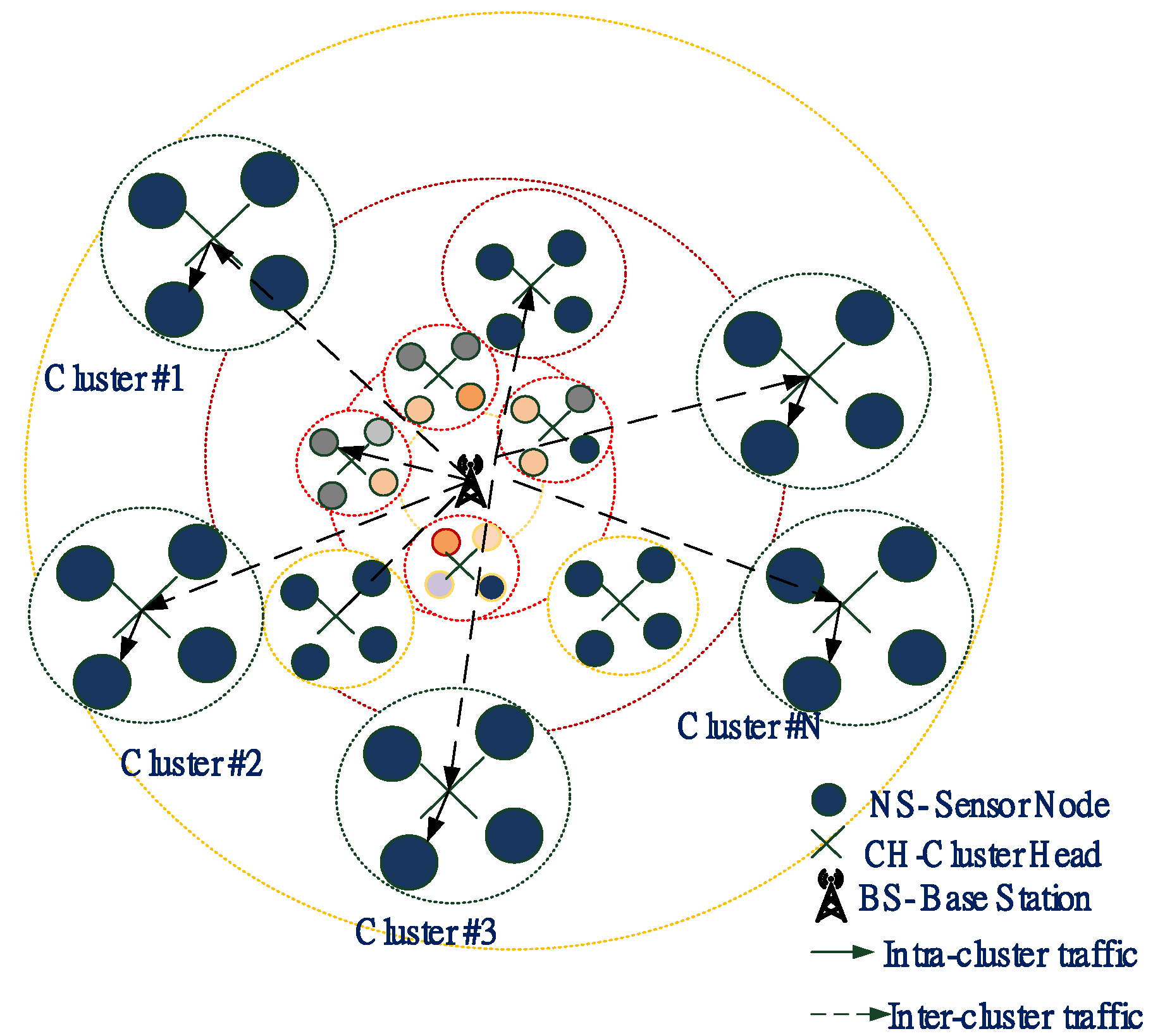
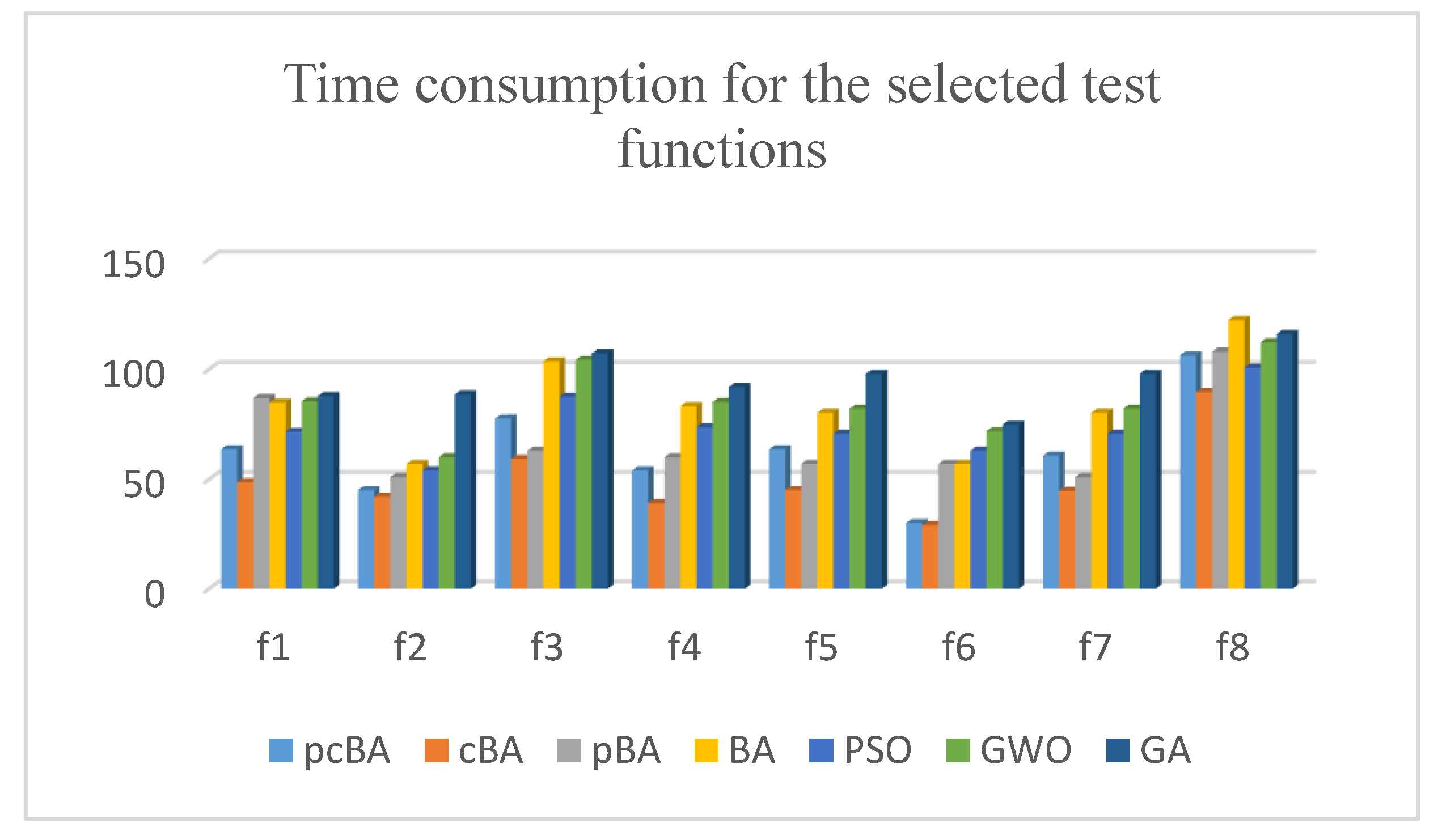
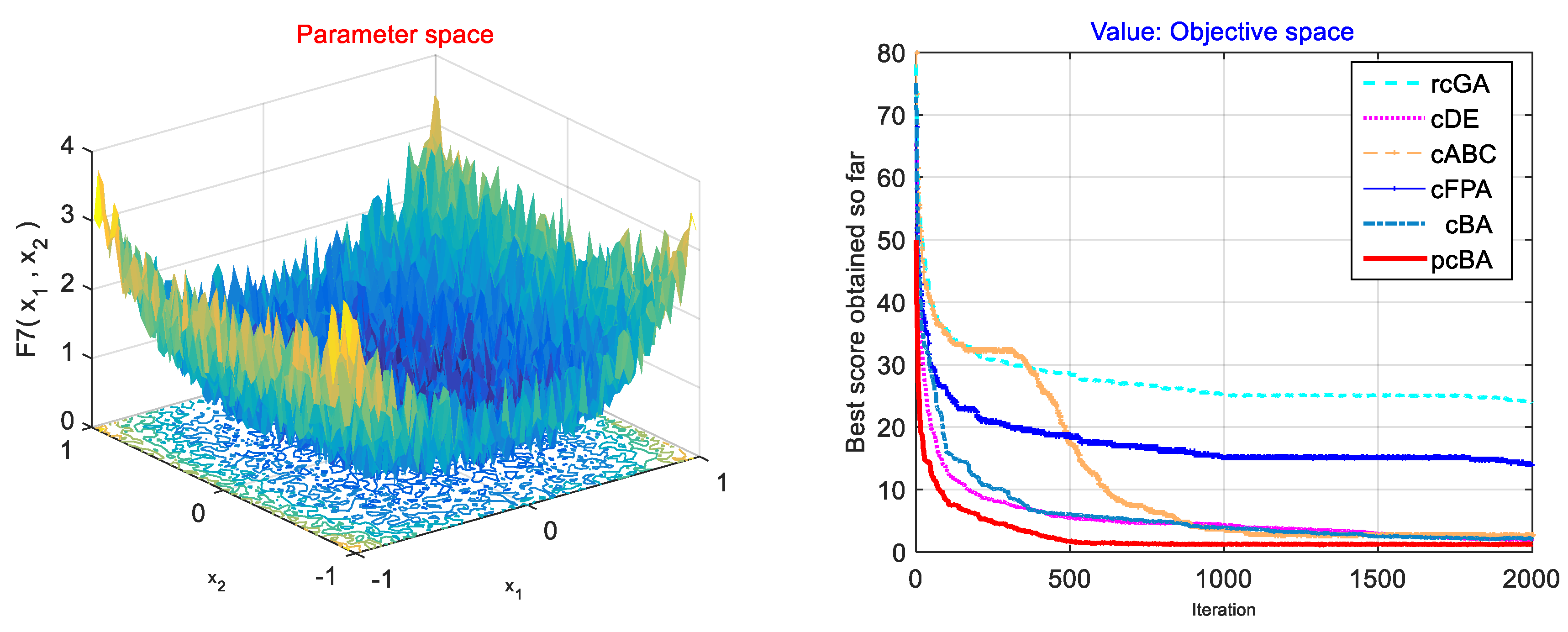
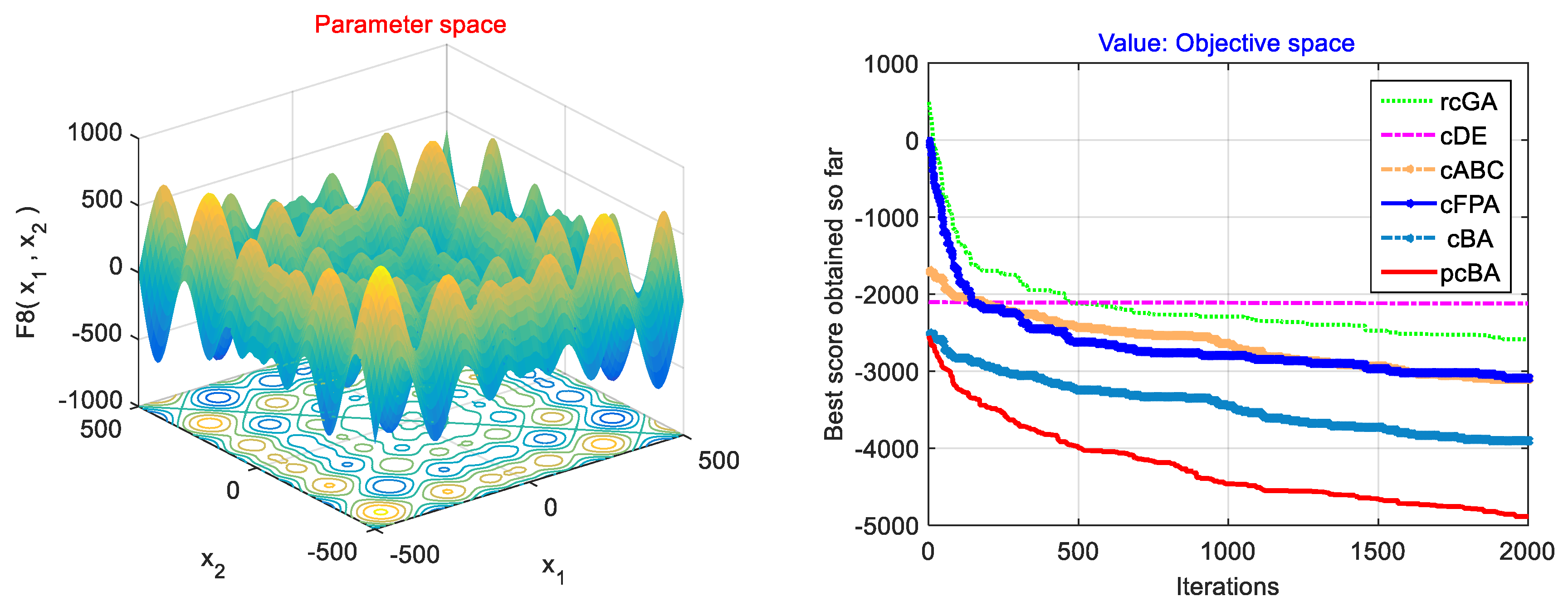
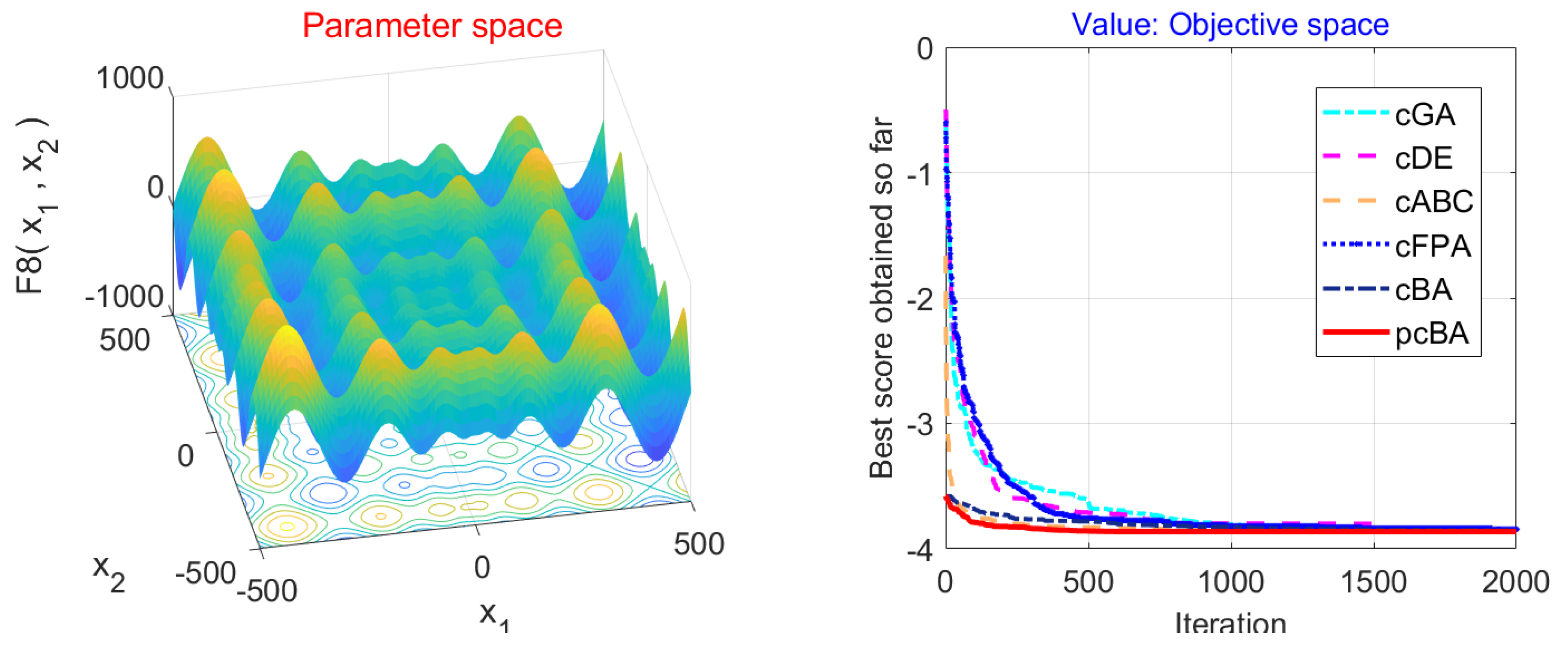
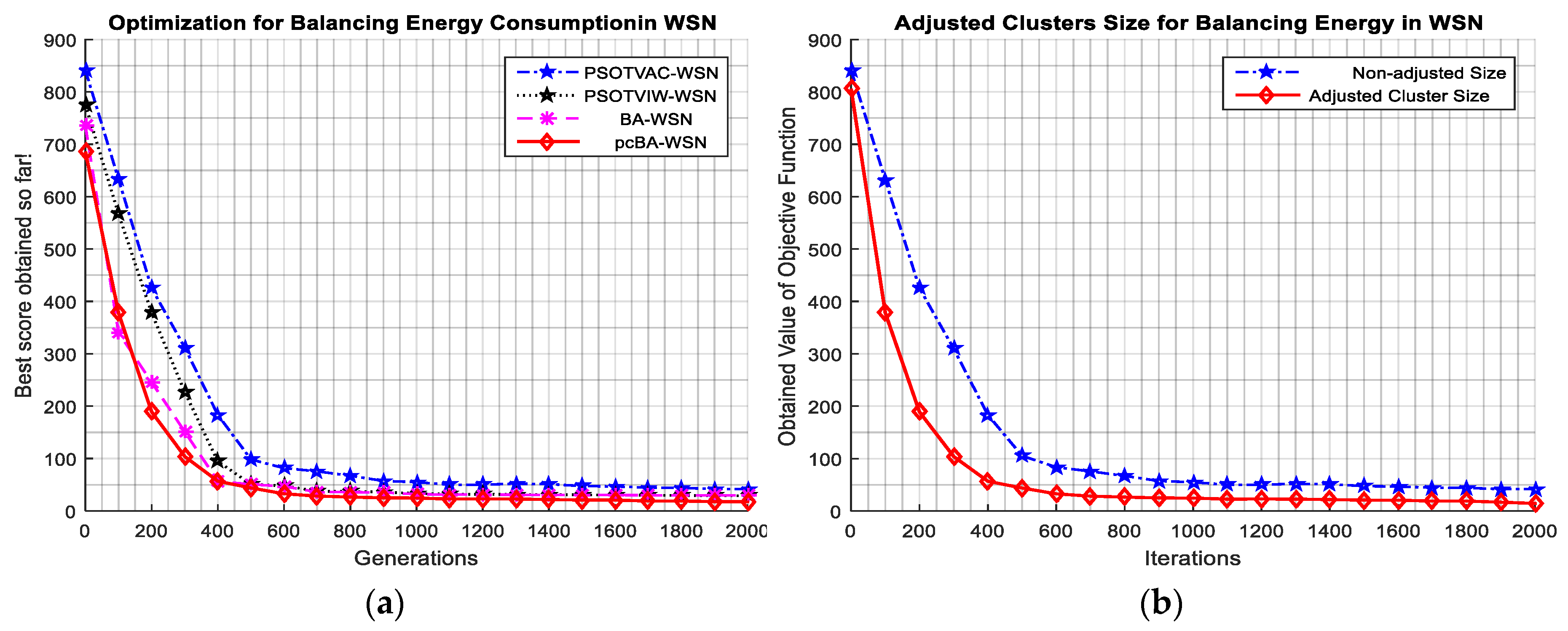
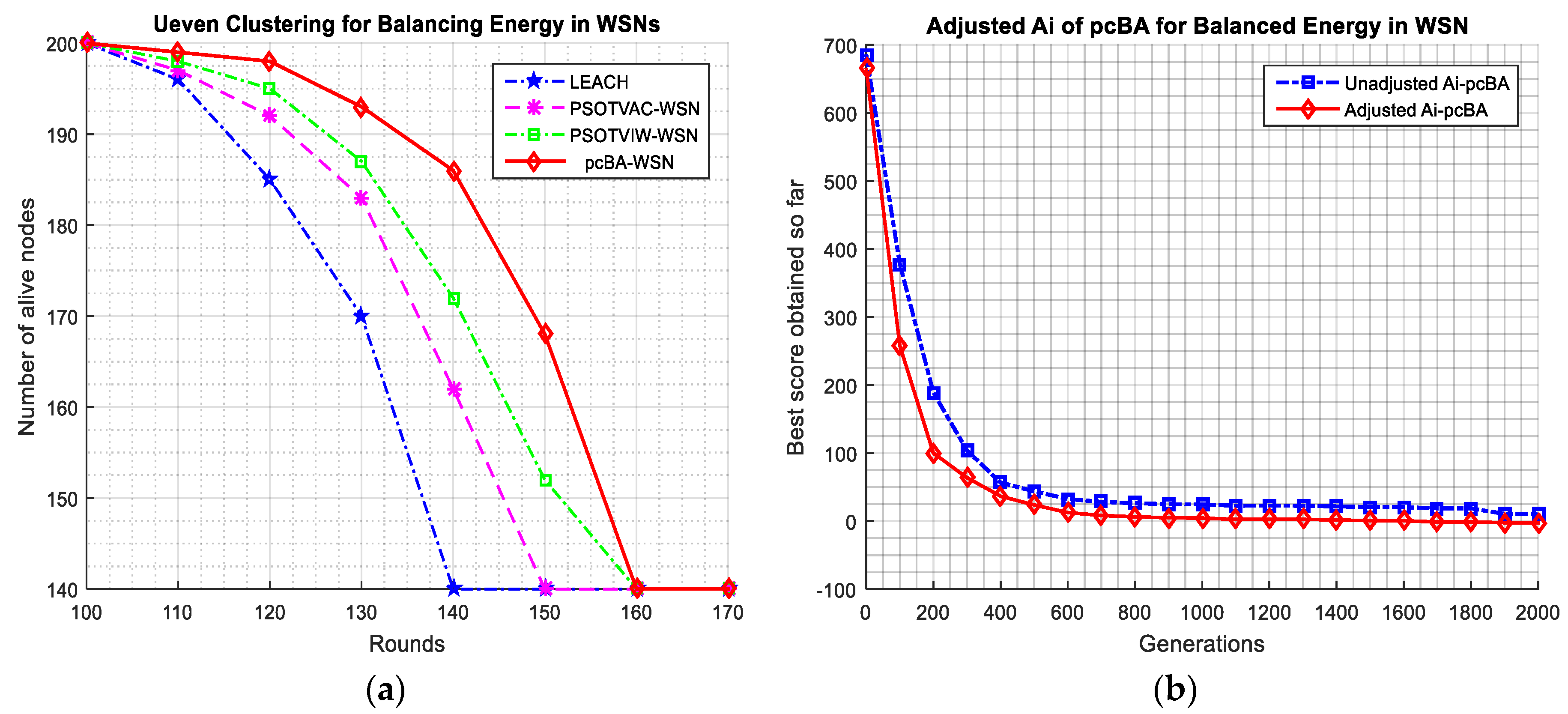
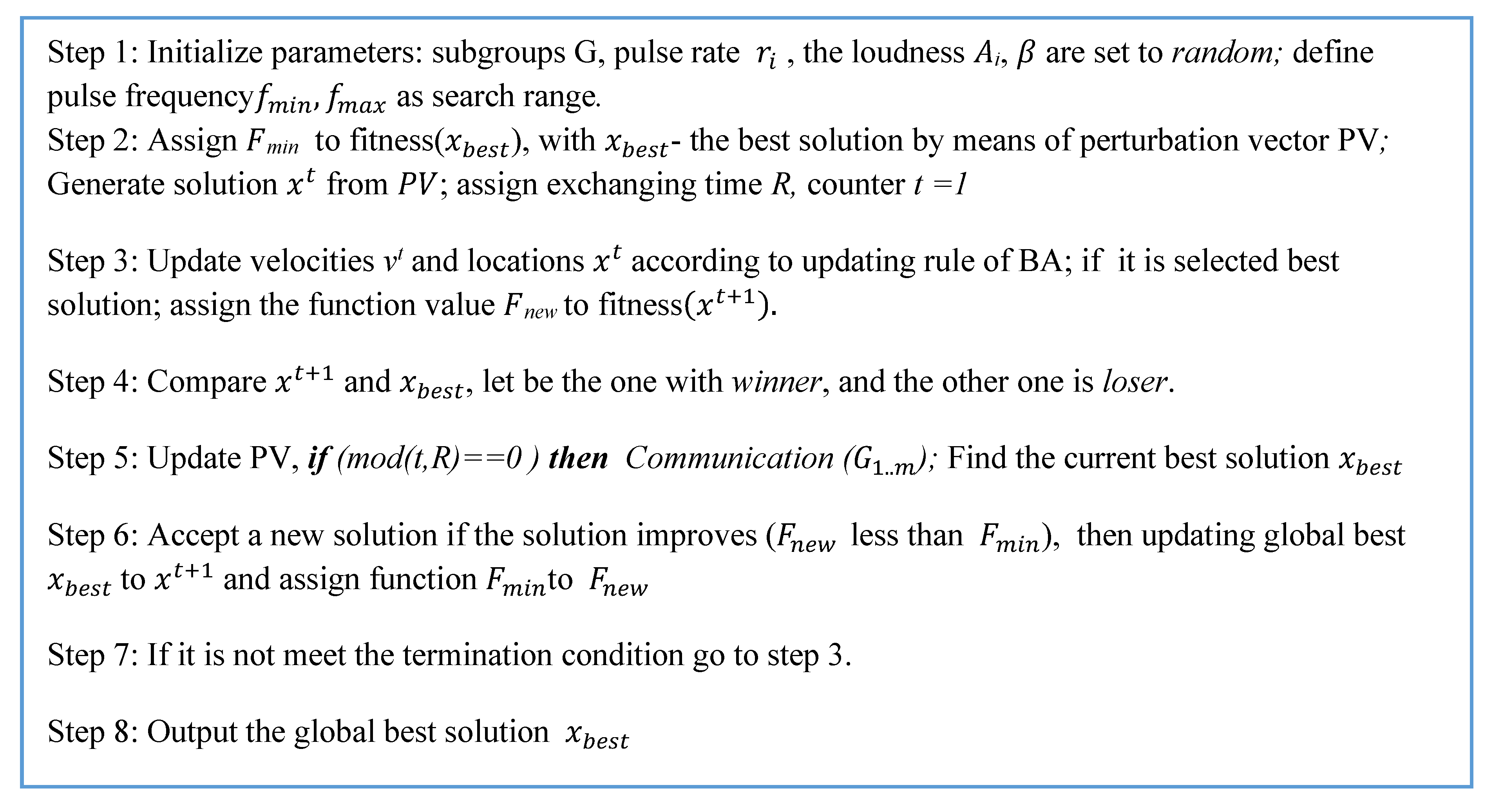
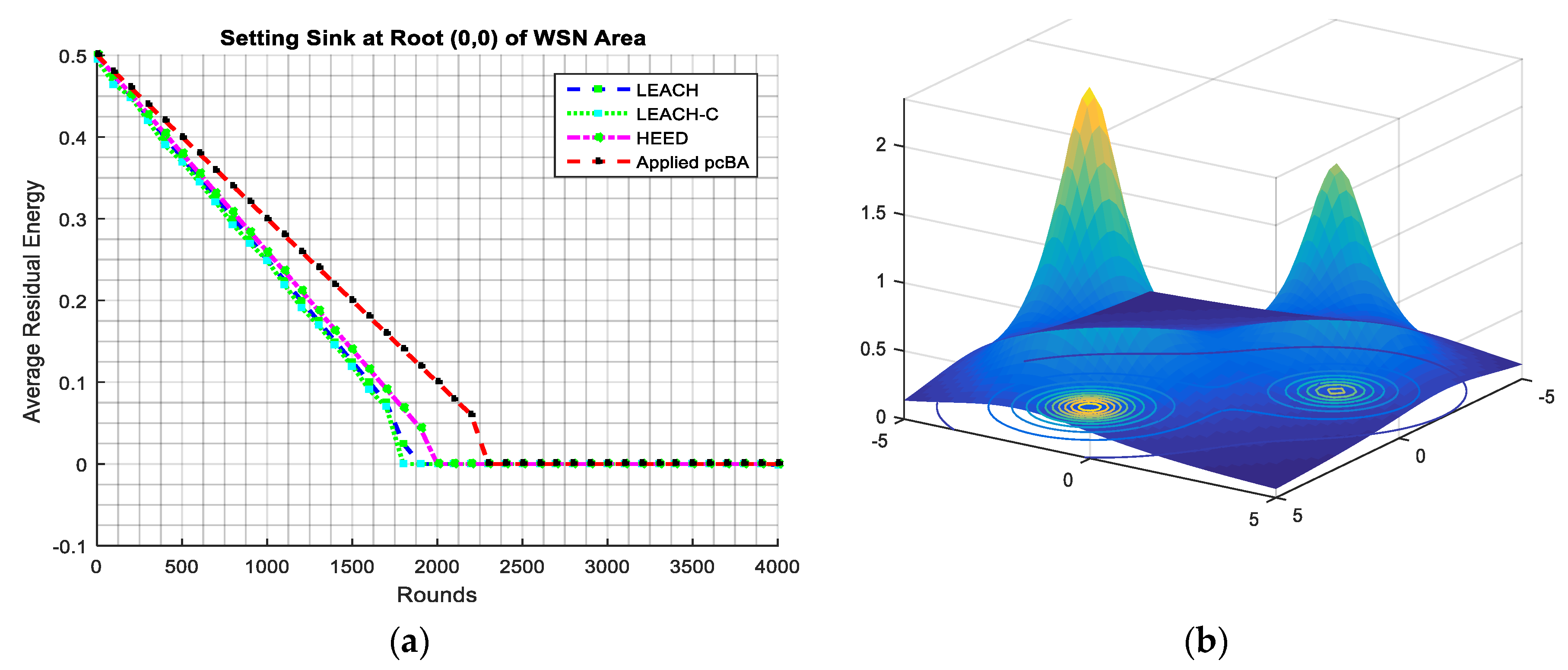

| Name | Test Functions | Range | Dimension | Iteration |
|---|---|---|---|---|
| Rosenbrock | 30 | 2000 | ||
| Quadric | 30 | 2000 | ||
| Ackley | 30 | 2000 | ||
| Rastrigin | ] | 30 | 2000 | |
| Griewangk | 30 | 2000 | ||
| Spherical | 30 | 2000 | ||
| Quartic Noisy | 30 | 2000 | ||
| Schwefel | 30 | 2000 | ||
| Langermann | 30 | 2000 | ||
| Shubert | 30 | 2000 | ||
| Dixon & Price | 30 | 2000 | ||
| Michalewicz | 30 | 2000 | ||
| Schaffer N.2 | 30 | 2000 | ||
| Matyas | 30 | 2000 | ||
| Drop-Wave | 30 | 2000 |
| Functions | pcBA | BA | r | cBA | r | pBA | r |
|---|---|---|---|---|---|---|---|
| 9.20E−01 | 1.56E+00 | + | 1.07E+00 | + | 9.56E−01 | ~ | |
| 3.38E+00 | 4.34E+00 | + | 3.68E+00 | ~ | 3.49E+00 | + | |
| 1.53E+00 | 4.11E+00 | + | 2.10E+00 | + | 1.96E+00 | + | |
| 4.29E−01 | 5.62E−01 | + | 4.55E−01 | + | 4.29E−01 | ~ | |
| 1.17E+01 | 2.28E+01 | + | 2.44E+01 | + | 1.19E+01 | ~ | |
| 2.15E+00 | 6.79E+00 | + | 2.15E+00 | ~ | 2.38E+00 | + | |
| 2.64E+00 | 4.13E+00 | + | 3.61E+00 | + | 2.46E+00 | - | |
| −4.37E+02 | −3.67E+02 | ~ | −4.09E+02 | ~ | −4.17E+02 | ~ | |
| 8.57E+01 | 1.38E+02 | + | 1.15E+02 | + | 9.57E+01 | + | |
| 1.93E+00 | 1.93E+00 | - | 1.96E+00 | ~ | 1.70E+00 | - | |
| 4.70E−02 | 1.34E−01 | + | 6.06E−02 | ~ | 4.16E−01 | + | |
| 1.91E−01 | 5.48E−01 | + | 2.83E−01 | + | 6.38E−01 | + | |
| 2.08E+00 | 3.17E+00 | + | 2.29E+00 | + | 2.63E+00 | + | |
| 9.79E+00 | 1.14E+01 | + | 8.86E+00 | - | 8.14E+00 | - | |
| 9.82E−03 | 2.78E−02 | ~ | 1.57E−02 | + | 3.36E−02 | ~ | |
| AVG | −2.10E+01 | −1.12E+01 | + | −1.03E+01 | + | −1.90E+01 | + |
| Summary | 13+ 2~ 1- | 10+ 5~ 1- | 8+ 5~ 3- | ||||
| Functions | pcBA | DE | r | PSO | r | GWO | r | GA | r |
|---|---|---|---|---|---|---|---|---|---|
| 9.20E−01 | 9.31E−01 | ~ | 7.54E−01 | - | 1.09E+00 | + | 1.25E+00 | + | |
| 3.38E+00 | 3.34E+00 | + | 3.49E+00 | + | 4.09E+00 | + | 4.38E+00 | + | |
| 1.45E+00 | 1.24E+00 | + | 1.91E+00 | + | 2.19E+00 | + | 2.91E+00 | + | |
| 4.29E−01 | 5.93E−01 | + | 4.37E−01 | + | 4.93E−01 | ~ | 4.60E−01 | ~ | |
| 1.17E+01 | 1.21E+01 | + | 1.04E+01 | - | 1.34E+01 | + | 1.98E+01 | + | |
| 2.15E+00 | 2.20E+00 | ~ | 2.38E+00 | + | 2.40E+00 | ~ | 2.17E+00 | ~ | |
| 2.64E+00 | 2.92E+00 | + | 2.46E+00 | ~ | 3.12E+00 | + | 7.40E+00 | + | |
| −4.33E+01 | −3.63E+01 | + | −2.70E+01 | + | −8.46E+00 | + | −1.25E+01 | + | |
| 5.76E+00 | 5.39E+00 | ~ | 6.40E+00 | + | 6.39E+00 | + | 6.80E+00 | + | |
| 1.90E+00 | 2.40E+00 | - | 2.69E+00 | + | 2.36E+00 | + | 2.19E+00 | + | |
| 4.70E−02 | 4.16E−01 | + | 4.16E−01 | + | 4.16E−01 | + | 1.22E+00 | + | |
| 1.92E−01 | 3.81E−01 | + | 2.38E−01 | ~ | 3.90E−01 | + | 3.75E−01 | + | |
| 2.08E+00 | 2.63E+00 | + | 2.63E+00 | + | 2.63E+00 | + | 3.95E+00 | + | |
| 9.79E+00 | 1.03E+01 | ~ | 1.11E+01 | + | 9.30E+00 | - | 1.27E+01 | + | |
| 9.82E−03 | 8.33E−02 | + | 3.36E−01 | ~ | 8.33E−02 | + | 6.47E−02 | ~ | |
| AVG | −5.88E−02 | 5.73E−01 | + | 1.24E+00 | + | 2.66E+00 | + | 3.55E+00 | + |
| Summary | 11+ 4~ 1- | 11+ 3~ 2- | 12+ 3~ 1- | 13+ 3~ 0- | |||||
| Functions | pcBA | cABC | r | cFPA | r | cDE | r | rcGA | r |
|---|---|---|---|---|---|---|---|---|---|
| 9.25E−01 | 9.54E−01 | ~ | 7.39E+00 | + | 1.51E+00 | + | 9.44E−01 | ~ | |
| 3.38E+00 | 2.99E+00 | - | 1.15E+01 | + | 4.61E+00 | + | 1.02E+01 | + | |
| 1.53E+00 | 1.51E+00 | ~ | 6.10E+00 | + | 4.92E+00 | + | 7.45E+00 | + | |
| 3.67E−01 | 1.53E−01 | - | 7.94E−01 | + | 6.98E−01 | + | 7.99E−01 | + | |
| 1.17E+01 | 1.34E+01 | + | 1.11E+01 | ~ | 2.23E+01 | + | 1.76E+01 | + | |
| 2.15E+00 | 3.91E+00 | + | 1.01E+01 | + | 1.72E+00 | - | 5.17E+00 | + | |
| 2.64E+00 | 8.81E+00 | + | 2.05E+01 | + | 5.49E+00 | + | 7.40E+00 | + | |
| −4.37E+01 | −2.50E+01 | + | −2.67E+01 | ~ | −2.38E+01 | + | −1.25E+01 | + | |
| 8.57E+01 | 1.21E+02 | + | 1.08E+02 | + | 7.94E+01 | - | 1.28E+02 | + | |
| 1.93E+00 | 1.66E+00 | - | 3.55E+00 | + | 1.81E+00 | + | 3.18E+00 | + | |
| 4.70E−02 | 5.93E−02 | ~ | 3.46E−01 | + | 9.39E−02 | ~ | 3.22E−01 | + | |
| 4.91E−01 | 9.81E−01 | + | 1.75E+00 | + | 8.24E−01 | + | 1.32E+00 | + | |
| 2.08E+00 | 6.93E−01 | - | 4.67E+00 | + | 6.07E−01 | - | 1.95E+00 | - | |
| 9.79E+00 | 1.22E+01 | + | 1.01E+01 | + | 1.27E+01 | + | 1.23E+01 | + | |
| 9.82E−03 | 2.40E−02 | ~ | 1.93E+00 | + | 6.32E−02 | ~ | 2.75E−02 | ~ | |
| AVG | 5.27E+00 | 9.55E+00 | + | 1.14E+01 | + | 7.52E+00 | + | 1.23E+01 | + |
| Summary | 8+ 4~ 4- | 14+ 2~ 0- | 11+ 2~ 3- | 13+ 2~ 1- | |||||
| Node i | |||
|---|---|---|---|
| 1 | 0.4984650 | 0.000090 | 0.4983750 |
| 2 | 0.4985640 | 0.000056 | 0.4985080 |
| 3 | 0.4984960 | 0.000070 | 0.4984260 |
| 4 | 0.4986160 | 0.000204 | 0.4984120 |
| 5 | 0.4985520 | 0.000077 | 0.4984750 |
| 6 | 0.4985480 | 0.000079 | 0.4984690 |
| 7 | 0.4984300 | 0.000364 | 0.4980660 |
| 8 | 0.4977127 | 0.000068 | 0.4976447 |
| 9 | 0.4985010 | 0.000074 | 0.4984270 |
| 10 | 0.4987388 | 0.000065 | 0.4986738 |
| Index | Nodei | 1 | 2 | 3 | 4 | 5 | 6 | 7 | .. | N |
|---|---|---|---|---|---|---|---|---|---|---|
| x | 05 | 65 | 95 | 100 | 75 | 60 | 45 | 40 | .. | 10 |
| y | 01 | 5 | 10 | 30 | 15 | 20 | 45 | 60 | .. | 80 |
| Index | Nodei | 1 | 2 | 3 | 4 | 5 | 6 | 7 | 8 | .. | n |
|---|---|---|---|---|---|---|---|---|---|---|---|
| CH | i | 0 | 0 | 0 | 0 | 1 | 0 | 0 | 0 | .. | 0 |
| Parameters Noticed | Denoted Symbols | Initial Values |
|---|---|---|
| Initial node energy | Ej | 0.5 J |
| Data aggregation energy | EDA | 5 nJ/bit/signal |
| Receiving and transmitting energy | Efs | 10 pJ/bit/m2 |
| Radio electronics energy | Eelec | 50 nJ/bit |
| Number bit of a data message | l | 1024 bit |
| Amplifier energy | Emp | 0.013 pJ/bit/m4 |
| Number of nodes in WSN | N | 100/200/300/nodes |
| Space distribution | M | 100/200/300 m |
| Population size (or virtual size for compact) | Pop | 40 |
| Iteration (generations) | MaxIteration | 2000 |
| Maximum of the loudness of BA | 0.5 | |
| Minimum of the loudness of BA | 0.25 | |
| Minimum bats’ frequency | 0 | |
| Maximum bats’ frequency | Number of nodes | |
| Bats’ pulse emission | 0.35 | |
| Number of runs | runs | 25 |
| Exchanging time for communication | R | 25 |
| Methods | Pop. Size | Iterations/a run | Min | Max | Mean | Std. | Running Time (m) |
|---|---|---|---|---|---|---|---|
| [21] | 40 | 2000 | 5.72E+01 | 8.41E+02 | 2.57E+02 | 2.87E+02 | 3.01E+00 |
| [21] | 40 | 2000 | 6.80E+01 | 6.35E+02 | 2.25E+02 | 2.83E+02 | 3.10E+00 |
| BA-WSN [42] | 40 | 2000 | 6.93E+01 | 7.57E+02 | 2.03E+02 | 2.69E+02 | 3.26E+00 |
| The applied pcBA-WSN | 1x4 | 2000 | 5.65E+01 | 7.65E+02 | 2.01E+02 | 2.32E+02 | 2.04E+00 |
| Number of Nodes | Methods | The Round at FND | The Round at LND | Total SMS Packages |
|---|---|---|---|---|
| 100 (0, 0) | Applied pcBA | 4328 | 4446 | 439389 |
| HEED [43] | 3684 | 4432 | 432564 | |
| LEACH-C [41] | 4140 | 4272 | 414937 | |
| LEACH [24] | 3504 | 3902 | 383441 | |
| 100 (center) | Applied pcBA | 4612 | 6627 | 654988 |
| HEED [43] | 4612 | 6798 | 669816 | |
| LEACH-C [41] | 4308 | 4333 | 428438 | |
| LEACH [24] | 3586 | 4182 | 404223 |
© 2019 by the authors. Licensee MDPI, Basel, Switzerland. This article is an open access article distributed under the terms and conditions of the Creative Commons Attribution (CC BY) license (http://creativecommons.org/licenses/by/4.0/).
Share and Cite
Nguyen, T.-T.; Pan, J.-S.; Dao, T.-K. A Novel Improved Bat Algorithm Based on Hybrid Parallel and Compact for Balancing an Energy Consumption Problem. Information 2019, 10, 194. https://doi.org/10.3390/info10060194
Nguyen T-T, Pan J-S, Dao T-K. A Novel Improved Bat Algorithm Based on Hybrid Parallel and Compact for Balancing an Energy Consumption Problem. Information. 2019; 10(6):194. https://doi.org/10.3390/info10060194
Chicago/Turabian StyleNguyen, Trong-The, Jeng-Shyang Pan, and Thi-Kien Dao. 2019. "A Novel Improved Bat Algorithm Based on Hybrid Parallel and Compact for Balancing an Energy Consumption Problem" Information 10, no. 6: 194. https://doi.org/10.3390/info10060194
APA StyleNguyen, T.-T., Pan, J.-S., & Dao, T.-K. (2019). A Novel Improved Bat Algorithm Based on Hybrid Parallel and Compact for Balancing an Energy Consumption Problem. Information, 10(6), 194. https://doi.org/10.3390/info10060194







